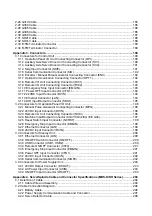
(3) Adjustments
CAUTION
Check and adjust programs and each parameter before starting operation. Failure to observe this
could result in unpredictable operations depending on the machine.
Do not make drastic adjustments or changes as the operation could become unstable.
(4) Usage
CAUTION
Install an external emergency stop circuit so that the operation can be stopped and the power turns
OFF immediately when unforeseen situation occurs. A contactor, etc., is required in addition to the
shutoff function mounted in the controller.
Turn OFF the power immediately if any smoke, abnormal noise or odor is generated from the
controller, drive unit or motor.
Only a qualified technician may disassemble or repair this product.
Do not alter.
Use a noise filter, etc. to reduce the effect of electromagnetic disturbances in the case where
electromagnetic disturbances could adversely affect the electronic devices used near the drive unit.
Use the drive unit, motor and each regenerative resistor with the designated combination. Failure to
observe this could result in fires or faults.
The combination of the motor and drive unit that can be used is determined. Be sure to check the
models of motor and drive unit before test operation.
The brakes (electromagnetic brakes) mounted in the servomotor are used for the purpose of
holding, and must not be used for normal braking. Also, do not run the motor with the motor brake
applied. Motor brake is used for the purpose of holding.
For the system running via a timing belt, install a brake on the machine side so that safety can be
ensured.
Be sure to confirm SERVO OFF (or READY OFF) when applying the electromagnetic brake. Also,
be sure to confirm SERVO ON prior to releasing the brake.
When using the DC OFF type electromagnetic brake, be sure to install a surge absorber on the
brake terminal.
Do not connect or disconnect the cannon plug while the electromagnetic brake’s power is ON. The
cannon plug pins could be damaged by sparks.
After changing programs/parameters, or after maintenance/inspection, always carry out a test
operation before starting actual operation.











































